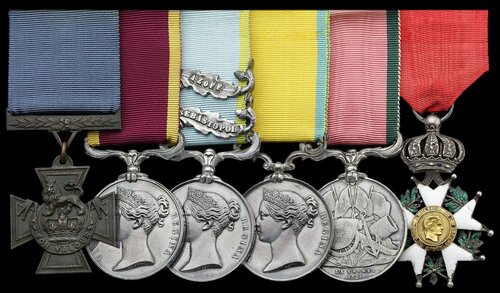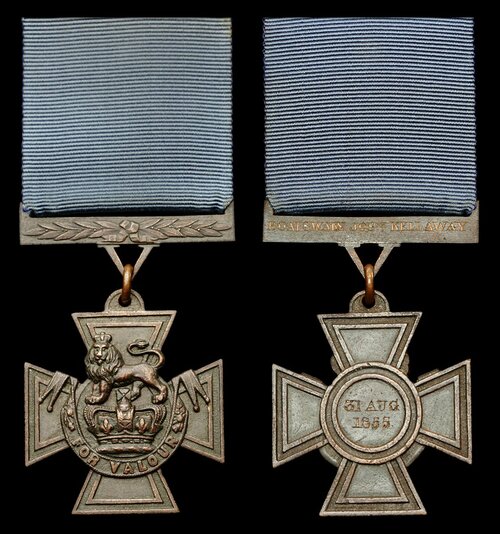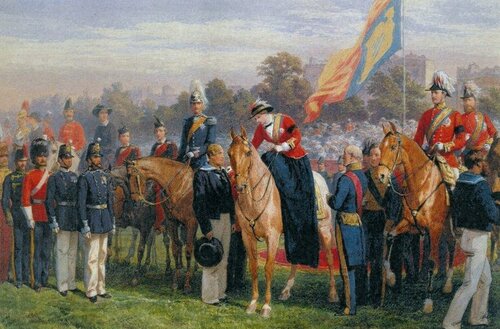Auction: 20003 - Orders, Decorations and Medals
Lot: 1
The very rare 'Sea of Azoff' V.C. group of six awarded to Chief Boatswain J. Kellaway, Royal Navy, decorated for his remarkable valour after finding his party of Bluejackets outnumbered ten-to-one whilst on a commando-style raid on Marionpol on 31 August 1855; Kellaway found himself fighting off five Russians - one who had him tethered by the beard - in order to go to the assistance of a comrade that appeared wounded
Having eventually been captured, the party were tied to trees and expected to be executed at any moment but were spared and saw out the remainder of the War as prisoners; his award would be listed in the notable 24 February 1857 issue of the London Gazette containing the first ever awards of the Victoria Cross and Kellaway would become just the 7th man in history to be invested with his richly-deserved award from the hand of Queen Victoria in June 1857
(a)
Victoria Cross, the reverse of the suspension bar officially inscribed 'Boatswain Josph. Kellaway' and the reverse of the Cross '31 Aug 1855'
(b)
China 1842 (Joseph Kellaway, H.M.S. Sapphire.), officially impressed naming, with replacement Crimea-style suspension
(c)
Crimea 1854-56, 2 clasps, Sebastopol, Azoff (Boatswain Josh. Kellaway.)
(d)
Baltic 1855 (Boatswain Josh. Kellaway.)
(e)
Turkish Crimea 1855, Sardinian die (Boatswain Josh. Kellaway.), with replacement Crimea-style suspension
(f)
France, Second Empire, Legion of Honour, breast Badge, silver, gold centre and enamel, third, fourth and fifth with contemporarily engraved naming, last damaged, fair, remainder good very fine (6)
Provenance:
J. B. Hayward, August 1971.
V.C. London Gazette 24 February 1857:
'"Whilst Boatswain of Wrangler, in the sea of Azoff, was taken prisoner after a stout resistance, whilst endeavouring to rescue Mr Odevaine, mate.”
This gallant service was performed on shore near Marionpol. A detachment, consisting of Mr Odevaine, Mate, Mr Kellaway, Boatswain, and three Seamen, had been despatched from the Wrangler to endeavour to burn some boats, fishing stations, and hay-stacks, on the opposite side of a small lake. They had nearly reached the spot when they were fired upon by a party of fifty Russian soldiers, who suddenly rushed from their ambush, and endeavoured to cut off their retreat. One man fell into the enemy's hands, but Mr Kellaway, and the two other seamen, had contrived to make good their escape, when Mr Odevaine accidentally fell. Mr Kellaway, apparently imagining him to be wounded, without a moment's hesitation returned to his rescue, risking his own life to succour his Commanding Officer. Unfortunately, while lifting up Mr Odevaine, they were surrounded by the enemy, and notwithstanding a gallant but hopeless resistance by Mr Kellaway, they were both made prisoners. Commander Burgoyne, who has furnished these particulars, observes, “I was myself an observer of the zeal, gallantry, and self–devotion that characterised Mr Kellaway's conduct”. (Despatches from Admiral Lord Lyons, of 8th September, 1855, No. 746; and of 22nd September, 1855, No. 796)'
Joseph Kellaway was born at Kingston, Dorset on 1 September 1824 and was baptised at Stinsford, Dorchester on 13 August 1826, the sixth child of John, a carpenter and dairyman.
Early service
Kellaway entered the Royal Navy at Portsmouth on 13 October 1841 and served aboard Sapphire during the 1842 operations - earning one of 65 Medals issued to that ship. Remaining on the China station, he was promoted Boatswain 3rd Class aboard Reynard and survived her wreck on 31 May 1851. She had been called to the assistance of Velocipede which had become caught on the shelf, but she herself was wrecked on the Pratas Islands. It took Pilot to rescue them - Kellaway included - and also the crew of Velocipede. Reynard could not be saved, and she was paid off as a total loss on 27 February 1852. Kellaway was clearly to the fore as Commander Cracroft said:
'...his conduct was in every way deserving of my approbation, and I consider him a most valuable officer and one who will do credit to the service.' (Southern Times & Dorset County Herald, 16 October 1880, refers)
Kellaway thence served aboard St George, Boscawen, Poictiers and other guard ships at Portsmouth and Chatham, climbing the ranks as Boatswain. Married at Portsea on 28 December 1853, he was made Boatswain aboard Tartarus on 4 April 1854 and joined Wrangler, a steam screw gunboat, on 19 June 1854.
Bluejacket V.C.
Having served in the Baltic operations, it then formed part of the Flying Squadron which operated in the Sea of Azoff. An article in Spink Insider sets the scene:
'The Sea of Azoff lies to the north east of the Black Sea and is connected to it only by the narrow Straits of Kertch and Yenikale. Extending for about 90 miles north to south and 190 east to west, it is notoriously one of the shallowest seas on earth, the water only a few feet deep in most places, but it was nevertheless an important supply line for Russian forces, allowing the passage of men, materiel and supplies from other parts of the Russian Empire to the forces in the Caucasus and Crimea. All around the sea were fishing villages, farms, small ship yards and ports whose supplies of food and goods, especially fish, hay, grain, tar and timber, were of great importance to the Russian war effort. Its most important port was Rostov, but coastal towns like Azov, Taganrog, Mariaupol, Gheisk, Genitichi and Berdiansk were also locally significant as ports and producers of foodstuffs.
While the land campaign “before Sebastopol” was being waged in the winter of 1854 and the summer of 1855, early consideration was given to an attack on the ports of the Sea of Azoff. However, not until May 1855, when the siege of Sebastopol seemed to settling into something of a stalemate, was a serious expedition launched into the Sea. A large-scale Anglo-French naval force was ordered into the Straits of Kertch, carrying French and British troops intended to seize the major towns of Kertch and Yenikale, which they quickly and easily did; the Russians offered hardly any resistance and chose instead to destroy their fortifications and retreat inland.
The large warship fleet and its landing parties having secured the access point to the Sea, it was now time to unleash the squadron which was to operate within its shores throughout the summer of 1855. Because the Sea of Azoff is so shallow – especially around its actual coastline – no major British warships could operate within its limits. Therefore, a powerful squadron of smaller screw and paddle-steamers, “gunboats” requiring less depth of water, was sent into the Sea. This “Flying Squadron” initially comprised the Miranda, Vesuvius, Stromboli, Medina, Ardent, Arrow, Beagle, Lynx, Snake, Swallow, Viper, Wrangler and Curlew, with five French steamers in support. Their commander was the dynamic Captain Edmund Mowbray Lyons – the son of the commander of the British fleet in the Black Sea – and already well-known for his exploits in HMS Miranda around Kola in the White Sea. Because these were smaller warships with small crews, many of their commanders were young men, often no more than Lieutenants, anxious to make a name for themselves and given considerable opportunity to show their powers of initiative and command.'
Between May and November 1855, these allied warships, sometimes in ones and twos and sometimes acting together in larger groups, simply wrought havoc along the coasts of the Sea of Azoff. They quickly halted all seaborne trade and fishing within the Sea, stopping and seizing any Russian vessels running between the coastal towns. In just three days of patrolling – the very first days of the allied invasion of the Sea – Lyons’ ships destroyed over two hundred enemy vessels, ninety on 29th May alone. The small Russian warship squadron at Kertch fled into the Sea, where it was scuttled and the Russian “Azov Squadron” never ventured to sea to challenge what then happened. All along the coast the major towns were “visited” – some of them repeatedly over the summer months – and anything deemed to be a worthy target lying along the shore was attacked and (usually) destroyed.'
One such worthy target was Marionpol, when Kellaway was landed as a Bluejacket for the 'commando' style raid. On 31 August 1855 however, the British would run head on into grouped Russian troops, armed to the teeth and ready for action.
As recalled in the citation for his Victoria Cross, Kellaway and their party indeed found themselves outnumbered ten to one. Their actions, in the finest traditions of the Royal Navy, showed no appetite for a simple surrender. Kellaway recalled:
'Five men sprang upon me, four laying hold of my hands and feet, while the fifth held on to my beard.
By dint of struggling I succeeded at last in throwing off four of my captors, but the remaining one managed to retain his hold upon my beard until the rest, recovering themselves, came to his assistance. Taking me by the heels, they pulled me along in that position for a long distance
Eventually, Mr Odevaine, a Seaman, and myself were tied to trees, a good space apart, expecting every moment to be shot; our anticipations on that score were fortunately not realised and we were shortly afterwards taken up into the interior as far as Taganrog.' (ibid)
Little more is known to the experiences of Kellaway and his comrades whilst prisoners of war - but is safe to assume they were not furnished with any luxuries. With the war officially ending on 30 March 1856, Kellaway left Wrangler as Boatswain 2nd Class in June 1856. He joined Firebrand, Formidable, Edinburgh and Royal George.
Feted return home
Returned to London on 26 June 1857 for the inaugural investiture of the Victoria Cross by the Queen in Hyde Park. With Her Majesty mounted on horseback, she presented the first 62 awards to veterans of the Crimean War. With the senior service kicking off proceedings, Kellaway became the 7th recipient of the Victoria Cross. The events of that day were painted by Constantin Guys and George H. Thomas, with a colourful full-page supplement printed in the Illustrated London News for 'The New Order of Valour, featuring depictions of the most striking awards from this first investiture. It is no surprise the act of Kellaway was chosen and is observed in the bottom left position of six recipients.
Kellaway went afloat again, being made Boatswain 1st Class of Clio in 1861 and was discharged from her at Panama, proceeding to England with the following endorsement on his Certificate from Captain Miller:
'Mr Kellaway has gained, and justly so, the respect and esteem of every officer in the ship, and I beg to recommend him most strongly to their Lordships.'
His final postings were Asia, November 1861-July 1862 and Edgar, July 1862-December 1865, having been made Chief Boatswain on 28 May 1868. Promoted Foreman of Riggers at Chatham Dockyard, he was appointed Chief Boatswain of that Dockyard, a position he held from 1870-77.
Journey's end
Kellaway retired on 26 December 1877, the result of 'the first signs of the painful complaint which closed his zealous and honourable career', with a pension of £143 a year. He died suddenly at Chatham on 2 October 1880 and was buried with full Naval honours. His wife Hannah had two daughters, Hannah Phoebe and Ada. Ada died whilst an infant and Hannah Phoebe was unmarried.
Over the passage of time, his grave (No. 579, Kent Section N) in the Maidstone Road Cemetery had become rather overgrown, sunken and unloved. It was in 2014 that the care of his grave was handed over to The Victoria Cross Trust. Kellaway Road in Chatham was also named in his memory.
References:
The Azoff Campaign 1855, Duckers & Mitchell (Spink, London).
Illustrated London News, 28 June 1857.
Southern Times & Dorset County Herald 16 October 1880.
https://www.kentonline.co.uk/medway/news/sinking-and-overgrown--the-11778/
The First VCs: The Stories Behind the First Victoria Crosses in the Crimean War, John Grehan.
Chatham's Military Heritage, Clive Holden.
Subject to 20% VAT on Buyer’s Premium. For more information please view Terms and Conditions for Buyers.
Estimate
£180,000 to £220,000
Starting price
£170000



























